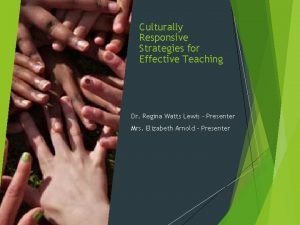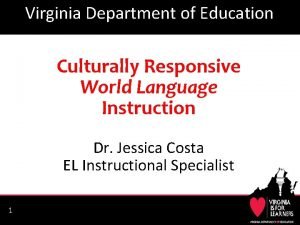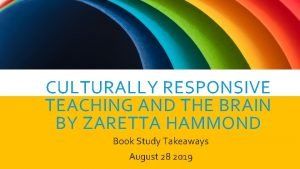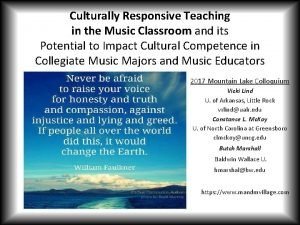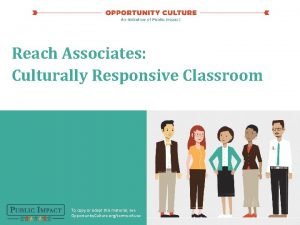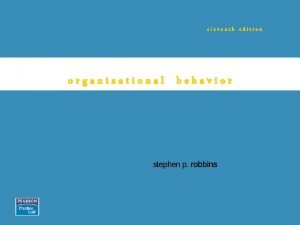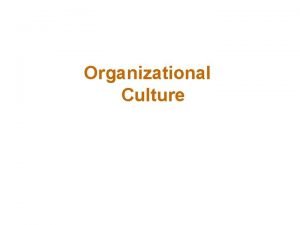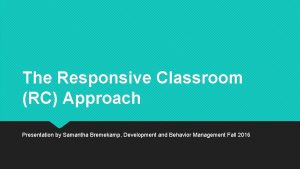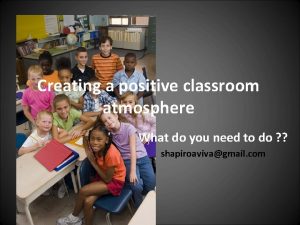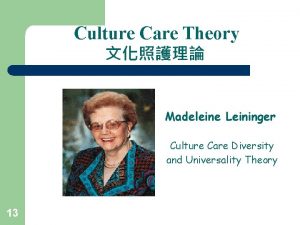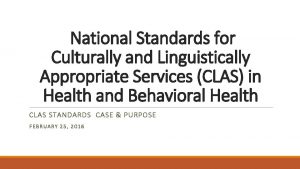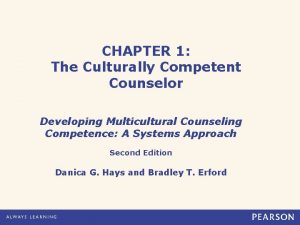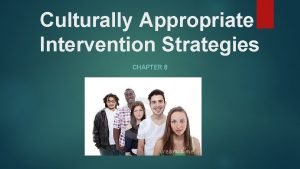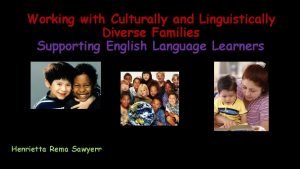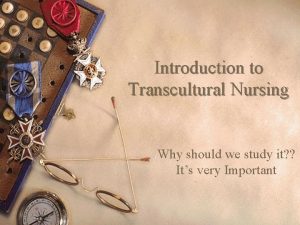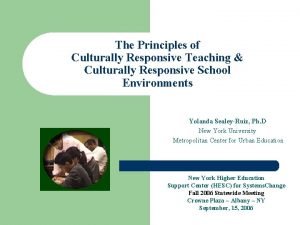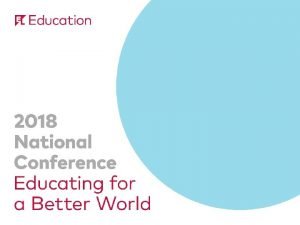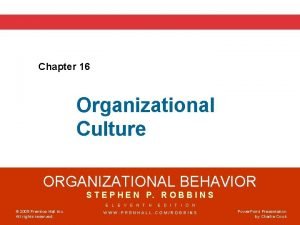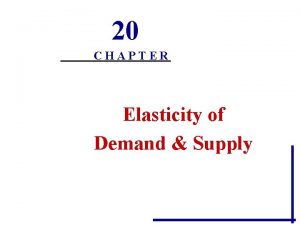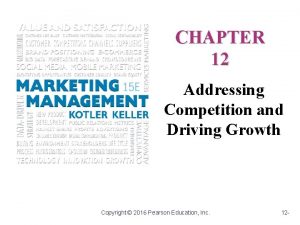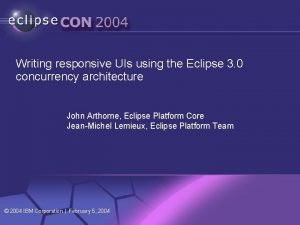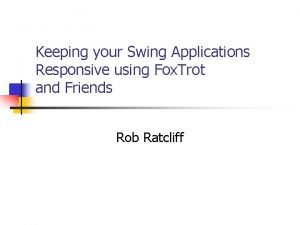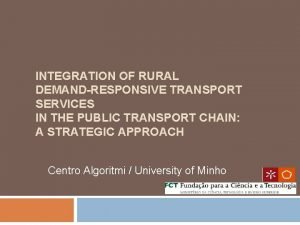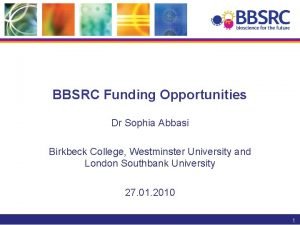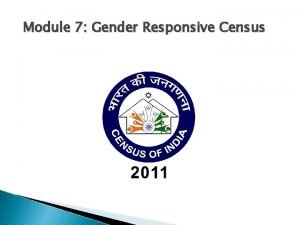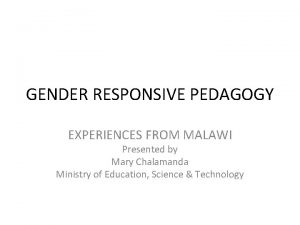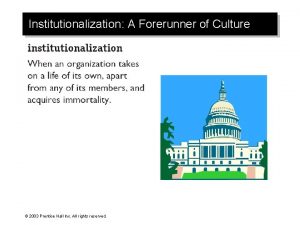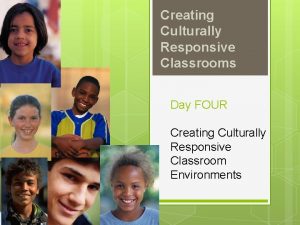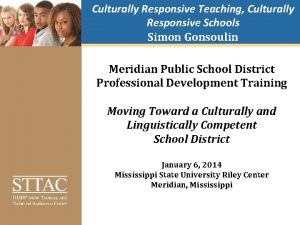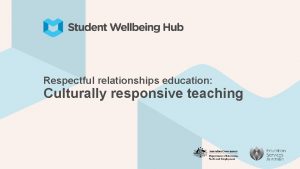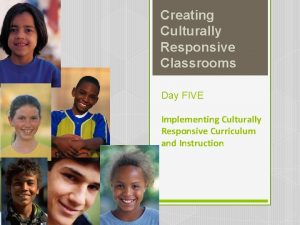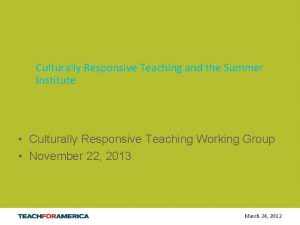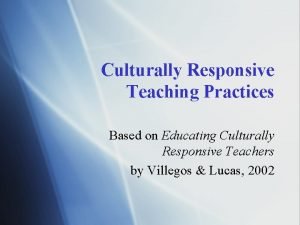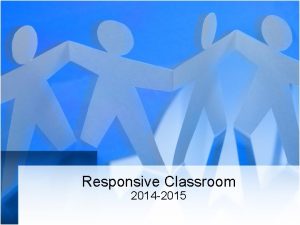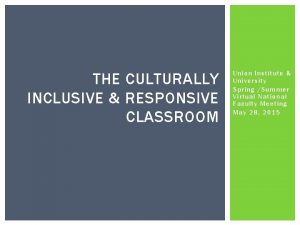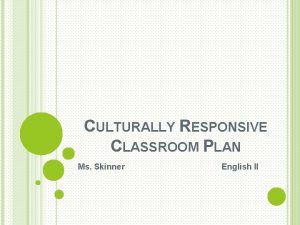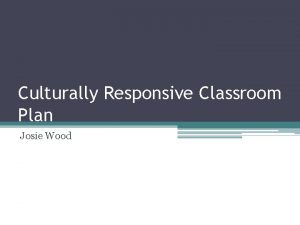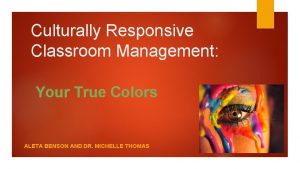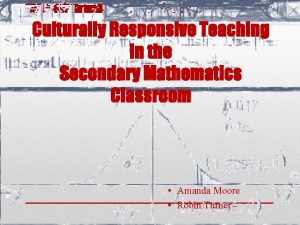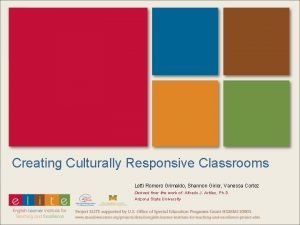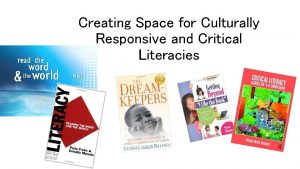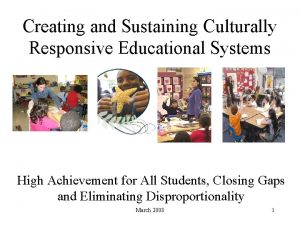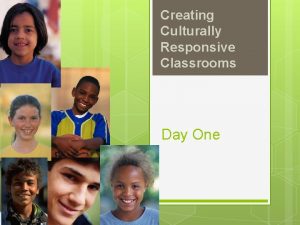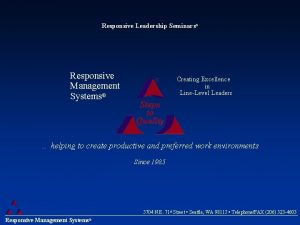Creating a Culturally Responsive STEM Classroom The Illinois




































- Slides: 36

Creating a Culturally Responsive STEM Classroom The Illinois Mathematics and Science Academy Adrienne Coleman, Ed. D. Ph. D. Sowmya Anjur, Director of Equity and Inclusion http: //works. bepress. com/adrienne_coleman acoleman@imsa. edu Science Faculty sanjur@imsa. edu

STEM (science, technology, engineering and mathematics) • “an interdisciplinary approach to learning where rigorous academic concepts are coupled with realworld lessons as students apply science, technology, engineering, and mathematics in contexts that make connections between school, community, work, and the global enterprise enabling the development of STEM literacy and with it the ability to compete in the new economy (National Center on Gifted and Talented, 2013). ”

STEM Significance Career Stability and Economic Development 80 70 66. 9 70. 8 60 50 40 30 20 10. 8 10 5. 5 0 White alone, not Black or African Hispanic or American alone Latino Total Workforce STEM 66. 9 70. 8 14. 9 14. 5 6. 4 10. 8 6. 4 Asian alone 5. 5 14. 5 0. 6 0. 4 4. 6 1. 4 1. 8 1. 9 Some Other Race American Indian and Native Two or More and Alaska Native Hawaiian or Races alone Other Pacific Islander alone 0. 6 4. 6 1. 8 0. 4 1. 9 6. 5 Total Workforce STEM Hispanic or Latino (of any race) 14. 9 6. 5 q According to the Washington-based Center for Political and Economic think tank, the U. S. workforce could employ as many as 140, 000 additional Black and Latino college graduates in STEM fields annually if the gap in college completion by Blacks and Latinos closed to roughly match that of the White and Asian student graduation rates. q According to the U. S. Census Bureau, the median income for Blacks is $32, 229 and $ 38, 624 for Latinos, almost $20, 000 less than Whites; but for Latinos and Blacks in STEM careers, the median income is

STEM Education Career Pipeline § While 44% of White students and 62% of Asian students scored at proficient or above in MATH, only 13% of Black students and 20% of Hispanic students did – 8 th grade (NAEP, 2017). § While the average score in Science was 166 for White students and 164 for Asian students, it was 132 for Black Students and 140 for Hispanic Students (NAEP, 2015).

STEM Education Fewer than 10% of Black and Latino students complete the high school mathematics sequence, which includes algebra, geometry, trigonometry, and pre-calculus. Latino and Black students are academically four years behind their White counterparts and score below approximately 75% of White America in mathematics. https: //nces. ed. gov/pubs 2010/2010015. pdf Career Pipeline

STEMTalks DIVERSIFYINGSTEMMATTERS “The National Academy of Sciences suggests that, without the participation of individuals of all races and genders, the increasing demand for workers in STEM fields will not be met, potentially compromising the position of the United States as a global leader” (2014). “The additional benefit of developing a STEM-literate and well-trained domestic workforce is that this ensures that we adequately address challenges related to healthcare improvement, national production capacity, and research excellence” (Allen-Ramdial & Campbell, 2014). “The National Action Council for Minorities in Engineering believes that diversity in STEM leads to improved decision-making, enhanced innovation and problem-solving” (2017).

Implicit Bias in STEM Our modern understanding of science and knowledge originates from the European Enlightenment. Nonwhites and women have historically been viewed as emotional, irrational, childlike, and not possessing scientific capabilities Beyond the structures that hinder minority gains in the sciences, interpersonal biases continue to be a factor for those who work in the STEM fields. Research continues to demonstrate how academic and work place settings are often spaces in which feminine and ethnic identities are not valued or recognized. The historical and institutional meaning of what it means to be a scientist (a white male identity) continues to underprivilege diverse populations.

Equity: Equity When Educational policies, practices, interactions, and resources, are representative of, constructed by, and responsive to all people such that each individual has access to, can participate, and make progress in high-quality learning experiences that empower them towards self-determination and reduces disparities in outcomes regardless of individual characteristics and cultural identities. Equity-Mindedness: • The outlook, perspective or mode of thinking exhibited by those who call attention to patterns of inequity and are willing to assume personal/institutional responsibility for the elimination of inequity. This includes being “conscious, ” noticing differences in experiences among cultural groups, and being willing to talk about race, gender, class, sexual orientation, ability, ethnicity as an aspect of equity. Equity perspectives are evident in actions, language, problem-solving, & cultural practices.

Equity-Mindedness

Methodology Diversifying STEM to Education Pathway, N = 415 Through qualitative research methodologies, students engaged in STEM, their parents, STEM educators, STEM professionals, and Community Organizations that implement STEM programming were asked to provide their perspectives and share their stories related to the intersection between race and STEM. • The Motivation of Black and Latino Students to Engage in STEM, n = 281 • 106 high school students, 86 middle school students, 27 STEM educators, 51 parents & 11 college students. • Diversifying STEM Think Tank, n = 134 from 64 organizations • To understand from the perspectives of STEM professionals, Educators, and Diversity/Inclusion Officers strategies to diversify and strengthen the STEM education to career pipeline. Critical Race Theory Attempts to understand American education and reform, acknowledging the unique perspective and voice of people of color as victims of oppression in racial matters and valuing their

Factors that Motivate Black and Latino Students to Engage in STEM Education Obligation to Black/Latino (nt = 281, nr = 655) 37 5. 6% 32 4. 9% Community/Break Negative Stigma - Be different Future Success/STEM is a Prominent, Progressive Field 16 3 2 2. 4%0. 5% 0. 3% Learning: Discovery of Knowledge and real-life applicability STEM Passion/Enjoyment 122 18. 6% 47 7. 2% Solve Problems/ To Advance Humanity 69 10. 5% 115 17. 6% 97 14. 8% 115 17. 6% Family/ Teacher Influence Challenge/ Competitive Nature of STEM Money Self-Motivated Not good at math nt = Total # of Participants, , ns=Total # of Responses Since subjects can respond more than once to the question, the values for nt and nr are often not equal. Leadership

Diversifying STEM Education to Career Pathway © 2018 Dr. Adrienne Coleman All rights reserved.

Culturally responsive pedagogy Instruction and interaction that allow students to maintain the integrity of their cultural identity, while succeeding academically and socially-emotionally. In culturally responsive pedagogy, faculty use aspects of students’ cultures in an asset-based approach as opposed to deficit-based to make academic and student life relevant to them, and increase their skill acquisition, engagement, and learning outcomes (National Institute for Learning Outcomes Assessment).

Culturally responsive Curriculum Racial Identity • People of Color, this framework focuses on the process by which African Americans come to understand their identity. • Bi-racial People this framework provides a description of biracial identity tensions and possible resolutions. • White People, this framework identifies a continuum that leads to developing an anti-racist identity. • Integrated Model, this framework begins and ends with stages that are thought to be the same for all people. “Encouraging Black and Latino/a students to share their racial or gendered experiences can help them realize they are not alone in contending with negative stereotypes about race” (Mc. Gee, 2016). It will also help other students understand the lived experiences of others and ideally become advocates for change. Social Justice and Social Responsibility • SPEAK UP, SPEAK OUT!!! Stereotype Management • Know Yourself – Prepare Yourself – Impact the situation when possible… • Cultivate Compassion - Create New Culture – Study History

The Value of A Culturally responsive pedagogy • We have an academic responsibility and a moral obligation to provide students with an inclusive education that will enable them to deal with the contingencies of living in a diverse world. • Research shows that when students are taught from an inclusive curriculum they are eager to learn; they are more engaged in the teaching/learning process. • Faculty who are involved in integrating diversity into their curriculum report that their teaching is revitalized, their student evaluations improved, and their overall job satisfaction increased. • It benefits both minority and majority students, especially in improving attitudes and feelings toward intergroup relations. • Has a positive impact on students’ attitudes toward racial issues, fostering opportunities for interacting in deeper ways with diverse perspectives and cognitive development.

Identity Responsiven ess Agency Relevance Culturally responsive STEM Curriculum

Diversity Curriculum A Diversity, Epidemiology and social justice unit was incorporated into my Pathophysiology curriculum in Fall 2016. There was initial opposition to this inclusion in the curriculum, as expected. At the end of the semester, it was very noteworthy that students were united in their thinking regarding diversity and inclusion, despite the fact that they were from different backgrounds and diverse cultures.

Diversity Curriculum In 2017, additional discussions were held on equity in education. Students who were otherwise reserved were encouraged enough to express their views, and everyone appreciated the fact that they had been included. In 2018, students held discussions on LGBTQ+ and equality in social situations. Students brought up many real life case studies in their discussions and debated on the “right” way to deal with gender identity and sexual orientation. This was a sensitive topic in the classroom but students had no hesitation to voice their opinions.

Diversity Curriculum In 2019, students got more vocal in expressing their opinions. They discussed equity in the classroom, school and the country, as well as the world. In addition to the topics previously discussed, they also talked about ethics in medicine such as the use of stem cells, designer babies and organ transplants.

Rationale Humans are by nature egocentric and socio centric as well. We believe that the groups we belong to are right, privileged, special. We systematically deceive ourselves into thinking that we are right, we avoid recognizing our biases and treat people and groups without due consideration and respect, even when there is clear evidence to refute our point of view. (Elder, 2004). Elder, L. (2004). Diversity: Making sense of it through Critical Thinking. The Critical Thinking Community.

Rationale (continued) Students at the Illinois Mathematics and Science Academy are selected for their aptitude in Math and Science Perception of inequality and exclusion among gifted population Promote awareness of natural egocentric and socio centric tendencies Reason unbiasedly through diversity issues

Goal of this Unit Through this unit, I hope to teach students to be aware of, and to guard against, their native egocentric and socio centric tendencies. Otherwise these tendencies will keep them from reasoning well through diversity issues. Students will also be able to recognize their inherent biases and be more tolerant of people different from them.

Introducing Diversity into the Science Classroom Pathophysiology is a Biology elective for juniors and seniors at IMSA that focuses on modeling changes in biological systems which disrupt homeostasis and result in diseases in the human body. The diversity unit was integrated into the nervous system unit because this seemed to be the best fit in the curriculum.

Introduction of Diversity Curriculum Students were given diversity topics and were provided with an introduction, rationale, recent events and a list of readings for these topics. They were required to synthesize the information with recent events and create a short presentation building specific case studies for discussion with their peers. Emphasis was placed upon discussions dissecting the ethics and moral dilemmas of recent events in the light of the background provided.

Incorporating Diversity Curriculum Two sections of 20 students each were provided with background information and asked to present to each other during the 100 minute class Students brought up many interesting views but were united in their thinking This was very noteworthy considering the fact that they were all from different backgrounds and diverse cultures.

Diversity Discussion Topics 2016 • Some of the topics discussed included: Brain preferences in terms of diversity Social and cultural influences on Diversity Thinking Diversity Development in the Brain Early development of diversity thinking Social justice and epidemiology and Selective Treatment in Hospitals Based on Race

Student Reflections on Diversity Discussions Students independently incorporated cases of social injustice against people of color into every single topic discussed. Students discussed causes for social injustice such as disparity in income, lack of education, and lack of tolerance toward people of other races. An interesting case study discussed was that of identical twins brought up in different environments, one tolerant and the other not tolerant toward people of color, and following their path through adolescence and adulthood. Their discussions brought forth many aspects of diversity that enhanced their learning by integrating real life experiences.

History of Diversity in Physiology 2017 In Fall 2017, students were introduced to additional diversity awareness through the development of the history of physiology and medicine. Special emphasis was placed upon social, racial and gender barriers. Students presented information from scholarly papers provided to them to set the background. They then discussed the situations presented and took sides voicing their opinions.

Student Discussions on History and Inventions It greatly benefitted students to be aware of the diversity, or lack thereof, of the times when these inventions and discoveries were made They appreciated better the circumstances of these discoveries and their modernization Students focused on specific events in the history of education and medicine and led short discussions on the ethics of the decisions made the modern reaction to these events and how knowledge of these events might improve their education and social awareness of justice and equality

LGBTQ+ Discussions 2018 Students were encouraged to discuss LGBTQ 1+ awareness in social situations Students pulled up specific case studies from recent news to discuss in class. Students showed no hesitation in discussing these topics and felt safe in voicing their opinions on gender identity and sexual orientation

Next Steps The success of this project has set the stage for development of diversity curriculum for other disciplines and other schools in the state of Illinois The ease of inserting this unit into an advanced biology course is encouraging and suggests that incorporation into other disciplines should be a smooth transition Students greatly benefit by relating to and thinking about diversity with respect to their learning Steps are under way to further develop this curriculum and train other educators to do the same in their academic institutions

LGBTQ+ Activity • Each person • picks a colored paper out of the hat • finds others who picked the same color • discusses their topic in their small group • gets together to discuss as a large group

The Crest of the Peacock Non-European Roots of Mathematics ü Case studies of India, China, and parts of Africa seem to indicate the existence of scientific creativity and technological achievements long before the incursions of Europe into these areas. • The standard treatment of the history of non-European mathematics exhibited a deeprooted historiographical bias in the selection and interpretation of facts, and that mathematical activity outside Europe has as a consequence been ignored, devalued, or distorted.

Dr. Rochelle Gutierre. Z: “Math was Never Neutral” Living Mathematx: Towards a Vision for the Future https: //files. eric. ed. gov/fulltext/ED 581384. pdf Ø ”Just like Whiteness, Math operates as an unearned privilege…” Ø “Who gets credit for doing and developing mathematics, who is capable in mathematics and who is seen as part of the mathematical community is generally viewed as white” Ø Dr. Gutiérrez introduces the term “Mathematx” to signify a humanizing re-imagination of mathematics free from dominance of Eurocentric and White culture, that takes into account Indigenous Knowledge. “Mathematx is a way of seeking, acknowledging, and creating patterns for the purpose of solving problems (e. g. , survival) and experiencing joy”. ⇢ Beginning with the principles of recognizing self and/in others, responsibility towards others, and valuing tensions, several things stand out as different from the typical way Western mathematics is conducted or experienced by students in school. ” ⇢ Living mathematx means moving through the world with other living beings, acknowledging, appreciating, and reciprocating the patterns produced. ⇢ Mathematx acknowledges that all persons will seek, acknowledge, and create patterns differently in order to solve problems and experience joy, multiple knowledges are valued and sought. ⇢ Mathematx allows for a variety of expressions without suggesting one is “normal, ” superior, or the reference point for erasing other epistemologies.

Equity and Excellence Policy https: //digitalcommons. imsa. edu/diversity_resources/2/ The Academy recognizes and acknowledges the historical underrepresentation and marginalization of culturally, linguistically, and economically diverse groups, both universally, and particularly, in STEM education and professions. These disparities also exist in the representation of the Academy’s workforce. We are committed to advancing equity in STEM education and representation and creating a diverse, inclusive community of global citizens who can realize their full potential, and execute our mission to advance the human condition, through a model of Equity and Excellence… Addressing Culturally, Linguistically and Economically Diverse and gender-based STEM education/career gaps by developing student and professional programs and services, as well as conducting research, that will inform strengthening and diversifying the STEM education to career pipeline.

References • Allen-Ramdial, S. and Campbell, A. (2014). Reimagining the Pipeline: Advancing STEM Diversity, Persistence, and Success. Bioscience. Retrieved from https: //www. ncbi. nlm. nih. gov/pmc/articles/PMC 4282132/ • Cook, L. (2015). The 2015 U. S. News/Raytheon STEM Index. Retrieved from http: //www. usnews. com/news/stem-index/articles/2015/06/29/the 2015 -us-news-raytheon-stem-index. • Crisp, G. and Nora, A. (2012). Overview of Hispanics in science, mathematics, engineering and technology (STEM): K – 16 representation, preparation and participation. Hispanic Association of Colleges and Universities. Retrieved from http: //www. hacu. net/images/hacu/OPAI/H 3 ERC/2012_papers/Crisp%20 nora%20%20 hispanics%20 in%20 stem% %20 updated%202012. pdf. • Crotty, J. M. (2011). Are Hispanics America’s Next Great STEM Innovators? Forbes. Retrieved from http: //www. forbes. com/sites/jamesmarshallcrotty/2011/11/22/arehispanics-americas-next-great-stem-innovators/. • Diverse Issues in Higher Education (2014). Economy misses out with low Black, Latino STEM employment. Retrieved from http: //diverseeducation. com/article/60944/. • Dumais, S. A. (2008). Cohort and gender differences in extracurricular participation: The relationship between activities, mathematics achievement, and college expectations. Sociological spectrum: Mid-South Sociological Association, 29(1), 72 -100. • Hutchinson, S. (2014). Who wants to be a rocket scientist? Race, gender and the STEM divide. Retrieved from http: //thehumanist. com/magazine/may- june-2014/up- front/who-wants-to-be-a-rocket-scientist-race-gender-and-the-stem-divide. • Illinois Mathematics and Science Academy. (n. d. ). Multicultural programs. Retrieved from https: //www 3. imsa. edu/admissions/multicultural. Programs • Illinois State Board of Education (2014). Illinois Report Card. Retrieved from http: //illinoisreportcard. com/State. aspx? source=Trends&source 2=Achievement. Gap&Stateid=IL • Khalifa, M. , Dunbar, C. & Douglas, T. (2013). Derrick Bell, CRT, and educational leadership. Race Ethnicity and Education, 16(4), 489 -513. Retrieved from http: //works. bepress. com/cgi/viewcontent. cgi? article=1011&context=ty-ron_douglas • Landivar, L. C. (2013). Disparities in STEM Employment by Sex, Race, and Hispanic Origin. United States Census Bureau. Retrieved from http: //www. census. gov/prod/2013 pubs/acs-24. pdf. • Mc. Gee, E. O. , & Martin, D. B. (2011 a). From the hood to being hooded: A case study of a Black male Ph. D. Journal of African American Male Education, 2(1), 46– 65. • National Center on Gifted and Talented (2013). STEM education and STEM schools: Definitions? Retrieved from http: //nrcgt. uconn. edu/wpcontent/uploads/sites/953/2015/04/STEM_e. Book. pdf. • National Center for Education Statistics (2013). The nations report card. Retrieved from https: //nces. ed. gov/nationsreportcard/pdf/main 2011/2012465. pdf. • National Science Foundation (2014). Revisiting the STEM workforce: A companion to science and engineering indicators. Retrieved from https: //www. nsf. gov/nsb/publications/2015/nsb 201510. pdf • Riegle-Crumb, C. and King, B. (2011). Questioning a white male advantage in STEM: Examining disparities in college major by gender and race/ethnicity. Retrieved from https: //liberalarts. utexas. edu/etag/_files/pdfs/articles/2010/Riegle-
 Culturally responsive vs culturally relevant
Culturally responsive vs culturally relevant Classroom
Classroom Vdoe culturally responsive teaching
Vdoe culturally responsive teaching Culturally responsive teaching and the brain powerpoint
Culturally responsive teaching and the brain powerpoint Culturally responsive teaching in music education
Culturally responsive teaching in music education Culturally responsive teaching self assessment
Culturally responsive teaching self assessment Customer-responsive culture
Customer-responsive culture Institutionalization organizational culture
Institutionalization organizational culture Responsive classroom youtube
Responsive classroom youtube Creating a positive classroom atmosphere
Creating a positive classroom atmosphere Outdoor stem classroom
Outdoor stem classroom Leininger sunrise model
Leininger sunrise model National culturally and linguistically appropriate services
National culturally and linguistically appropriate services Culturally competent counselor
Culturally competent counselor Culturally appropriate intervention strategies
Culturally appropriate intervention strategies Cultural deprivation
Cultural deprivation Working with culturally and linguistically diverse families
Working with culturally and linguistically diverse families Certified transcultural nurse
Certified transcultural nurse Pedagogy meaning
Pedagogy meaning Cse smart class
Cse smart class Fluid responsive shock
Fluid responsive shock Responsive
Responsive Customer responsive culture
Customer responsive culture Price elasticity of supply measures how responsive
Price elasticity of supply measures how responsive Https //forms.office.com
Https //forms.office.com Dementia
Dementia Responsive anticipation and creative anticipation
Responsive anticipation and creative anticipation Responsive uis
Responsive uis Java swing responsive gui
Java swing responsive gui Demand responsive transport
Demand responsive transport Responsive anticipation and creative anticipation
Responsive anticipation and creative anticipation Birkbeck university
Birkbeck university Gender responsive census
Gender responsive census Whatismyviewport
Whatismyviewport What is gender responsive pedagogy
What is gender responsive pedagogy Entry socialization options
Entry socialization options Responsive prayer
Responsive prayer
